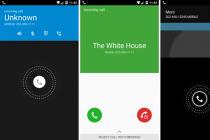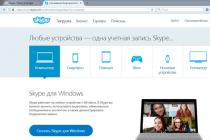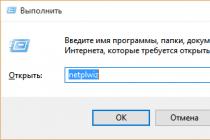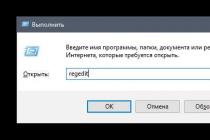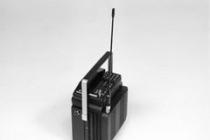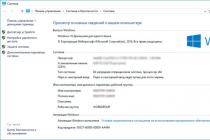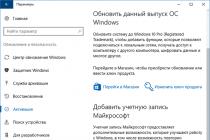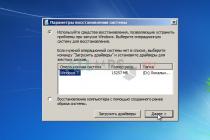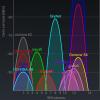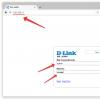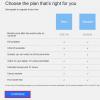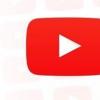The biggest discontent among users of previous versions of Windows when moving to a new operating system was caused by two things:
- By default, a new initial screen with "Tiles" opened, so to switch to the "familiar" desktop, you had to click on the corresponding tile. The next time I logged into the system, everything was repeated again.
- To turn off / restart the computer using the mouse, you had to "call the magic buttons, go into the parameters, select the shutdown item and select the desired action.
The "Start" button appeared in its usual place. By pressing right by clicking on this button, a convenient menu appears with the ability to immediately choose to turn off or restart the PC.

However, when the system starts, the tiles still open, and not the desktop. To configure the desktop to open instead of "tiles", you must first go to "Desktop". Then you need to click right by clicking on the "Taskbar".

Next, in the pop-up menu, select the "Properties" item. A window will open dedicated to all the settings of the taskbar and "navigation". It is the "Navigation" tab that we need to configure the opening of the desktop instead of the "initial screen". On this tab, we find the item "When you log in and close all applications, open the desktop instead of the start screen" and put a check mark.

Do not forget to click the "Apply" button, otherwise the changes made will not be taken into account. Now, when you turn on your computer or laptop, instead of the initial screen (tiles), the good old desktop will always open.
Recall that the owners licensed Windows 8 can update the system to Windows 8.1 absolutely free of charge - you can do it through " Windows Store". If you buy one of the versions of a Windows 8 product or
Many users who were waiting for the new Windows 8 were surprised that instead of the classic start menu they saw a start screen with a tiled interface. Microsoft promised to bring back the standard style, but we never saw it. After that, users wondered, how to make the start button in Windows 8 similar to Windows 7.
Return start button to windows 8 without third-party programs is not possible, so third-party programmers began to write their own software. By now, there are a decent number of programs. There are both free and paid applications, these include:
- Classic Shell
- Start Button 8
- Pokki
- StartMenu8
- Other
To change the launch, I see no reason to pay 3-5 bucks, when you can use not bad free options. Below we will consider several programs. They differ in the design of the start menu and in the presence of various settings. I think you will find your favorite among them.
How to restore Windows 8 Start Menu via Classic Shell
Classic Shell is free utility, which makes it possible to install the Windows 8 start button in the classic version. At its core, it replaces the start screen and contains a lot of settings for the needs of the user. Let's take a closer look at the algorithm of actions with this program.
1. Download the Russian version of Classic Shell, unzip and install it.
2. Click on start with the right button and select "setting" from the menu to change appearance and start menu configuration.
3. You will see the settings interface, consisting of 3-4 tabs, depending on the selected style. Configure for individual needs.

- Start menu style - the start tab, in which 3 design styles are available, and there is an option.
- Basic parameters - allows you to set the action for mouse clicks and keys, configures user needs, adds and removes items.
- Cover - sets the design of the selected style, as well as changes colors, size of icons, font.
- Start menu settings - here you can select the start elements, as well as their state.
If you want to produce more fine tuning, at the top of the window, check the box next to "show all options", which shows even more tabs.
4. After setting, click OK to save. As a result, you get the following picture.

How to make a start button in Windows 8 through Start Button 8
Start Button 8 has a paid and a free version. During installation, you can choose a paid edition with a large set of functions and use it for 30 days, after which you will be offered to buy the application or go to free version... Consider the program Windows 8 start menu recovery in more detail.
1. Download Start Button 8, unzip and install it (after installation is complete, do not uncheck the "start now" option).
2. Now click on the start button and click on settings.

3. A settings window will open containing 5 links with a set of parameters:
- System Integration - Be sure to leave the checkbox on the startup option along with Windows. Here you can set the keys for opening the start, actions with the start screen, control of active zones.
- Personalization - here we set up the visual design, scale, column width.
- Start button - changes the icon.
- Control - here we set a keyboard shortcut that is triggered when open menu start.
- Advanced options - advanced options.

4. After setting, close the window. Thus, you will get the familiar start button with quick access to other elements.

As you can see make the start button in Windows 8 a classic style possibly with a ton of applications. Basically these utilities don't change system files that allows with ease and without consequences. You can always find out more about all the possibilities on the developers' website.
Hello everyone. Today, friends, we will customize Windows again. We'll take the 8.1 version of the system and send it back in time. Not distant past. Let's make it look similar to Windows 7. Recently, readers of the site in the comments discussed the problem of the impossibility of installing the "Seven" on new devices with BIOS, where Secure Boot is not disabled - the function secure boot... Windows 7 cannot pass the Secure Boot Conditional Test. Only Windows 8.1 and 10 can pass it. Perhaps someday I will come across such a laptop or PC, and I will be able to find a solid solution to this issue. In the meantime, I propose to go through customization - to make Windows 8.1 look similar to Windows 7. And, perhaps, someone deliberately wants to work with more new version systems and nostalgic only for the interface of the "Seven".
Friends, below we will do the work to achieve the maximum similarity of the "Eight" with the "Seven". You can carry out not all operations, but selectively, according to your taste. But in any case, do not neglect security measures: during customization, there is an intervention in system settings, and this is a risk. Before you start repeating the steps described below, create, even better -.
Externally similar to Windows 7, you can make not only Windows 8.1, but also version 10. Version 8.1 in our case was chosen because of its stability, the absence of problems when installing patches for third-party themes, and, of course, because of the larger internal similarity to the "Seven". The "Eight" contains all the settings of the control panel. Whereas in the "Ten" with the latest cumulative update, most of them are already located only in the UWP application "Settings".
If the need Windows installations 7 is dictated by the weak hardware stuffing of the computer, you can use a stripped-down assembly.
Start Menu
We will start returning the Windows 7 interface with the main drawback of version 8.1 - the absence of the "Start" menu. To market it third-party software there are many products available. The article "" provides a comprehensive overview of such products. Also, friends, I can recommend something different from the classic type. For my own experiment, I will choose the well-known Classic Shell program. It's free, with very flexible settings, and better than other programs will allow me to make the "Start" menu the way it was in the "Seven".
When installing Classic Shell, you must deactivate the installation of components for Explorer and Browser Internet Explorer... We pursue our own specific goals, and we do not need tweaks for these areas of the system.

I downloaded an impressive collection of all sorts of different button designs as a package.
Returning to the Classic Shell settings. In the "Start Button" section, select the "Custom Button" item and specify the path to the design you like from the downloaded package. I will choose a button design similar to the actual button design in Windows 7.

In the "Cover" section, see that the "Windows 8" theme is installed.

And the last adjusting touch - in the "Menu View" section, turn on Aero Glass, the menu shadow, redefine the color so that it is as similar as possible to the color of the Windows 7 menu. Click "OK".

Disabling hot corners and starting the system from the start screen
Classic Shell and many other programs for implementing the "Start" button, among their configuration arsenal, provide options for bypassing the initial Modern UI screen when Windows startup 8.1 and turning off its hot corners - the edges of the screen, where the menu of the modern interface appears on hover. But I'll show you how these actions are configured using the system itself. We call the properties of the taskbar using the context menu on it.

In the "Navigation" tab, uncheck all the items in the "Actions for corners" column. In the column "Start screen" we activate the login to the system from the desktop. And we can also check the box for opening the application view when you exit to the home screen. Since by ourselves home screen we will not use it, and the Modern UI interface may be needed for some needs, there is a reason to implement access to it in the form of a complete list of software installed in the system.

Uninstalling Modern UI Applications
For Windows 8.1 to be similar to version 7, you need to remove the Modern UI applications from it. You won't be able to remove all of them, but you can get rid of most of them. Delete each separate application can be done using the context menu in the list of programs of the Modern UI interface.

Or you can resort to using the uninstaller to clean up the remnants of the Geek Uninstaller to be removed. He knows how to delete Modern UI applications, moreover, he cleans up the registry after them.

If you need to uninstall Modern UI applications in batch, i.e. everything, PowerShell will help. Run as administrator, enter the command:
Get-AppxPackage | Remove-AppxPackage

If there is a question about uninstalling Modern UI apps for everyone accounts Windows 8.1, and not only for the current one, we enter the command:
Get-AppxPackage -allusers | Remove-AppxPackage
Note: Friends, the above PowerShell commands will not work in Windows 8.1 Embedded environment. But this is not necessary, since this edition comes with a minimal package of Modern UI applications, they can be uninstalled one by one.
Lock Windows Store
The Store app will not be uninstalled in a separate order, nor will it disappear if you uninstall in bulk using PowerShell. You can just leave it alone. And so that children do not climb into it and do not download any nonsense from there, it is better to block the store. Launch the local group policy editor:
We pass the path indicated in the screenshot below. If you need to block the store only for the current account, open, as in the screenshot, the tree of the "User Configuration" section. If you need to block it for all accounts, we open, respectively, the same tree, but in the "Computer configuration" section. We click the parameter "Disable App Store".

We put a tick “Enabled”. We apply.

Image Viewer
The Modern UI "Photos" application is also one of those that "cannot be knocked out with an ax." To view pictures in the classic image viewer, you just need to designate it as the main one in the system. We go to the control panel, we go through the path:
Programs - Default Programs - Select Default Programs
Select the tool and click the button to use it as the default program.

Conductor
Next, we need a free tweaker utility OldNewExplorer. It returns the modern versions of the explorer operating system from Microsoft, the look that it had in Windows 7 is more ascetic, without a Ribbon-panel, with the appearance of a menu by pressing the Alt key and other nuances. The official site of the utility seems to be dead, but it can be downloaded without any problems on other Internet resources. For example, from the same Windows customization site where I took pictures for the Start button:
Launch OldNewExplorer, set the necessary checkboxes and click the "Install" button at the top. Which checkboxes are needed? In the screenshot below, the numbers indicate those that can be used in our case - when the goal is to simulate a conductor in the "Seven" style:
1 - displaying items in a hierarchical order, hiding user profile folders and adding a "Libraries" section instead;
2 - hiding the Ribbon panel;
3 - displaying the Aero Glass effect on the navigation bar;
4 - the use of alternative navigation buttons, if such are provided by the themes;
5 - displaying the information panel at the bottom of the window;
6 - display of the status bar.

As a result, on board modern Windows versions we get a conductor with a design and useful options from the past.

Theme of design
Now, friends, let's install a Windows 7-style theme. But first, you need to install a patcher on Windows 8.1. Downloading free program UltraUXThemePatcher from her official website:
Unpack the theme files and place them in a folder:
C: \ Windows \ Resources \ Themes

We go to the personalization section. For those with imitation of Windows 7, we are offered two options, but they are not very different. We choose any.

Aero glass
The highlight of Windows 7 is the Aero Glass effect. It can be implemented in Windows 8.1 using the program of the same name - Aero Glass. For details on this program, friends, read. The program seems to be free, but after installation it starts asking for donation in a pop-up window. And she also sculpts her watermark on the wallpaper. So, in the comments to that article, the readers of the site unsubscribed how they solved these problems. I will return to the specifics of using the program in the context of the topic of the article. And here important point: When installing the program, you must uncheck the installation of the Aero Glass theme. Otherwise, the theme with imitation of Windows 7 will not be displayed, it will be interrupted by the glass theme.

The fact of imitation is given, as you can see, by the brighter colors of Windows 8.1, the subtlest details in the theme and the Start menu are not realized everywhere, the use of the Aero Glass effect is different from the native one, and so on. But in general, the atmosphere, it seems to me, is sustained. In addition, you can additionally work with the brightness of the colors and make them less saturated, as in the "Seven".
And, finally, the final transformational touch: not so much for imitation, but simply for giving even more atmosphere, you can install the Windows 7 branded image on the lock screen.

Windows 8 is a fairly different system from previous versions. Initially, it was positioned by developers as a system for touch and mobile devices... Therefore, many things that are familiar to us have been changed. For example, a convenient menu "Start" you will not find it anymore, because it was completely decided to replace it with a pop-up sidebar Charms... And yet, we will consider how to return the button. "Start", which is so lacking in this OS.
You can return this button in several ways: using additional software or only system ones. We will warn you in advance that by means of the system you will not return the button, but simply replace it with a completely different utility that has similar functions. As for additional programs - yes, they will return you "Start" exactly what he was.
Method 1: Classic Shell
With this program you can return the button "Start" and completely customize this menu: both its appearance and its functionality. So, for example, you can put "Start" with Windows 7 or Windows XP, as well as just select the classic menu. As for the functionality, you can reassign the Win key, specify what action will be performed when you right-click on the icon "Start" and much more.

Method 2: Power 8
Another fairly popular program from this category is Power 8. With its help, you will also return a convenient menu "Start", but in a slightly different form. The developers of this software do not return the button from the previous ones versions of Windows, but offer their own, made especially for the eight. Power 8 has one interesting feature - in the field "Search" you can search not only by local drives, but also on the Internet - just add a letter "G" before asking to contact Google.

Method 3: Win8StartButton
And the last software on our list is Win8StartButton. This program was created for those who like the general style of Windows 8, but still inconvenient without a menu "Start" on the desktop. By setting this product, you will get the necessary button, when you click on it, some of the elements of the start menu of the eight appear. It looks rather unusual, but it fully corresponds to the design of the operating system.

Method 4: System Tools
Also you can make a menu "Start"(or rather, its replacement) regular means systems. This is less convenient than using additional software, but nevertheless, this method is also worth paying attention to.

We've looked at 4 ways you can use the button "Start" and in Windows 8. We hope we were able to help you, and you learned something new and useful.
Windows 8 Is the penultimate version of the system released by Microsoft today. As we expected, after the "Seven" we got the "Eight". And of course we need to learn install Windows 8 to immerse yourself in this latest operating system. I propose to do this today.
Let's consider the whole process of installing Windows 8, how it differs from installations of other versions of "Windows" and so on. But before you get down to business, you need to naturally announce the system requirements. It's simple!
To install windows 8 we need:
so that the processor is with clock frequency not less than 1 GHz
free hard disk space 20 GB or more
DirectX 9 support
In other words, if you previously had the "Seven" installed, then you should not bother with system requirements. Latest Windows 8 will work fine for you.
1. Where to get a disk with Windows 8
You can buy the program in a store or on the Internet. If you are from the network, then most likely you will have an uploaded image that will need to be written to an empty disk. How this is done, I told in the lesson:. If this information is relevant for you, then read it, everything is very simple there.
2. We put in BIOS boot from disk

